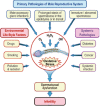Laboratory tests for oxidative stress
- PMID: 28717269
- PMCID: PMC5508430
- DOI: 10.4103/iju.IJU_9_17
Laboratory tests for oxidative stress
Abstract
Introduction: Oxidative stress (OS) is considered a significant contributor to male infertility. A number of laboratory techniques have been developed to evaluate oxidative stress in the semen. We review these tests and their current use.
Methods: A literature review was performed utilizing the PubMed search engine for articles studying OS etiology and impact on male fertility, and the laboratory tests used in its assessment.
Results: The state of OS results from exaggerated production of oxygen-derived free radicals, also known as reactive oxygen species, to an extent overwhelming the body's antioxidant defense mechanisms. Several laboratory tests have been utilized in OS measurement during male fertility evaluation. These tests are classified into direct assays which measure the degree of oxidation within a sperm cell and indirect assays which estimate the detrimental effects of OS. The chemiluminescence assay, flow cytometry, nitroblue tetrazolium assay, and cytochrome c reduction are examples of direct assays while the myeloperoxidase test and measurements of lipid peroxidation, oxidation-reduction potential, and total antioxidant capacity are examples of the indirect assays.
Conclusion: OS measurement is an important tool that may help in understanding the pathophysiology of male infertility and provide valuable information that would guide treatment decisions and patient follow-up.
Conflict of interest statement
Conflicts of interest: There are no conflicts of interest.
Figures



References
-
- Cooper TG, Noonan E, von Eckardstein S, Auger J, Baker HW, Behre HM, et al. World Health Organization reference values for human semen characteristics. Hum Reprod Update. 2010;16:231–45. - PubMed
-
- Kolettis PN, Lipshultz LR, McClure RD, Nangia AK, Naughton CK, Prins GS, et al. The optimal evaluation of the infertile male: AUA best practice statement. In: Jrrow J, Sigman M, editors. American Urological Association Education and Research. Linthicum, Maryland: American Urological Association, Inc; 2010. pp. 1–38.
-
- Agarwal A, Hamada A, Esteves SC. Insight into oxidative stress in varicocele-associated male infertility: Part 1. Nat Rev Urol. 2012;9:678–90. - PubMed
-
- Mahfouz RZ, du Plessis SS, Aziz N, Sharma R, Sabanegh E, Agarwal A. Sperm viability, apoptosis, and intracellular reactive oxygen species levels in human spermatozoa before and after induction of oxidative stress. Fertil Steril. 2010;93:814–21. - PubMed
Publication types
LinkOut - more resources
Full Text Sources
Other Literature Sources
Research Materials

